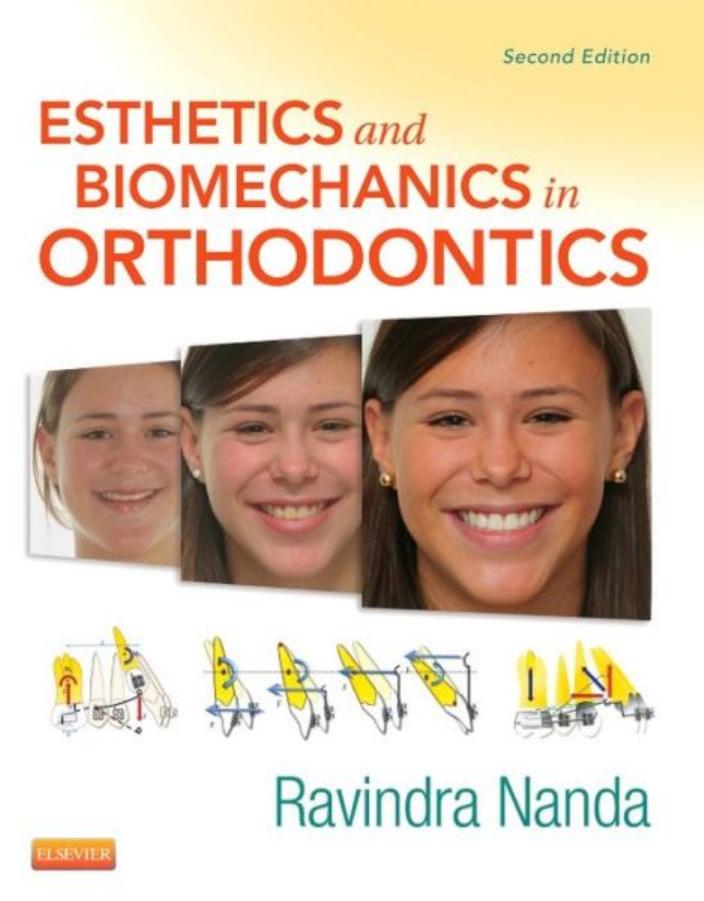Esthetics and Biomechanics in Orthodontics 2nd Edition by Ravindra Nanda ISBN 9781455750856 1455750859
$70.00 Original price was: $70.00.$35.00Current price is: $35.00.
Instant download Esthetics and Biomechanics in Orthodontics 2nd Edition after payment
Esthetics and Biomechanics in Orthodontics 2nd Edition by Ravindra Nanda – Ebook PDF Instant Download/Delivery: 9781455750856, 1455750859
Full dowload Esthetics and Biomechanics in Orthodontics 2nd Edition after payment

Product details:
ISBN 10: 1455750859
ISBN 13: 9781455750856
Author: Ravindra Nanda
Esthetics and Biomechanics in Orthodontics
Esthetics and Biomechanics in Orthodontics, 2nd Edition provides everything you need to know to successfully apply biomechanics in clinical orthodontics. This edition features new content in the areas of tooth movement, treating Class III malocclusions, skeletal anchorage, Surgery First treatment plans, and space closure. In addition to comprehensive guidance on basic biomechanic principles, this state-of-the-art reference also shows how all techniques can apply biomechanical principles to improve the force delivery, understand and prevent side effects, and achieve predictable results.
- Highly regarded lead author, Dr. Ravindra Nanda, is a widely known and respected educator in the field of orthodontics.
- Comprehensive coverage of diagnosis, treatment planning, and esthetics in tooth display provides a solid foundation in orthodontia and biomechanic problem solving.
- Case reports include high-quality photographs, radiographs, and illustrations to better show biomechanical principles.
- Radiographs and line drawings accompany clinical photographs to help illustrate the various stages of treatment.
- NEW! Content on the fundamentals that guide orthodontic tooth movement offers a clear understanding of how orthodontic appliances work and their role in designing treatment methodologies.
- NEW! Content on procedures and indications for optimal space closure helps you define priorities in treatment planning and understand all the treatment alternatives.
- NEW! Detailed information on biomechanics-based management of impacted canines provides treatment planning strategies and biomechanic techniques to achieve desired results without increasing treatment time.
- NEW! Coverage on modalities for the treatment of Class III malocclusions offers insight into new treatment protocols — such as corticotomy-assisted facemask therapy and corticotomy-assisted maxillary protraction — that are available to effectively treat these occurrences.
- NEW! Detailed information on the different forms of skeletal anchorage (including mini-implant technology) shows how certain challenges associated with types of tooth movement can now be overcome by applying sound biomechanical principles to skeletal anchorage.
- NEW! In-depth coverage of the Surgery First (SF) treatment plan offers step-by-step examples to help explain the technique of Sendai SF and its benefits
Esthetics and Biomechanics in Orthodontics 2nd Table of contents:
Part 1 Diagnosis and Esthetic Concepts
Chapter 1 Individualized Orthodontic Diagnosis
Clinical Examination
Radiographic Records
Diagnostic Models
Summary
References
Chapter 2 Individualized Orthodontic Treatment Planning
Treatment Objectives
Dynamics of Treatment Planning
Occlusogram, Visualized Treatment Objective, and 3D Virtual Planning
Case Reports
Summary
References
Chapter 3 Esthetics in Tooth Display and Smile Design
Evaluating Esthetics in the Dentist’s Chair
Standards of Normality
Vertical Position of the Incisors
Clinical Implications for Deep Overbite Correction
Midlines
Transverse Dimension
Crown Inclination Symmetry on Contralateral Teeth
How to Achieve Both an Optimal Smile and Dental Stability
Clinical Guidelines
Summary
References
Part 2 Biomechanics
Chapter 4 Biomechanics in Orthodontics
Approaches to Studying Tooth Movement
Basic Mechanical Concepts
Center of Resistance, Center of Gravity, and Center of Mass
Equilibrium and Newton’s Laws
Concept of Equilibrium
Equilibrium in Orthodontics (The Quasi-Static System)
Center of Rotation
Types of Tooth Movement ()
Orthodontic Force Systems: Applying the Laws of Mechanics
Summary
References
Chapter 5 Biological Mechanisms in Orthodontic Tooth Movement
Tooth Movement
Biological Responses in Clinical Treatment
Root Resorption
Orthodontic Relapse
Future Uses of Biological Principles in Orthodontic Treatment
References
Chapter 6 Biomechanical Basis of Extraction Space Closure
Fundamentals of Space Closure
Methods of Space Closure
Mini-Implant–Driven Mechanics of Tooth Movement
Summary
References
Chapter 7 Biomechanics-Based Management of Impacted Canines
Diagnosis of Canine Impaction
Surgical Exposure
Etiology
Biomechanical Considerations
Summary
References
Part 3 Management of Vertical Dimension Problems
Chapter 8 Management of Deep Overbite Malocclusion
Etiology
Diagnosis
Treatment
Implants for Deep Bite Correction
Retention and Stability
Summary
References
Chapter 9 Management of Open-Bite Malocclusion
Characteristics of Anterior Open Bite
Etiology
Treatment Strategies
Esthetics and Open Bite
Stability and Retention
Summary
References
Chapter 10 Molar and Incisor Positioning to Achieve Occlusal and Esthetic Objectives
The Importance of Maxillary First Molars
The Uprighting of Mandibular Incisors
Master and Slave Arches
Keeping the Teeth in the Center of the Bone
Summary
References
Part 4 Management of Class II Malocclusion
Chapter 11 Strategies for Treatment of Adolescent Patients with Class II Malocclusions
Dentofacial Characteristics of Class II Malocclusion
Growth Pattern
Limitations of Treatment
Growth Modification
Biomechanics of Functional Appliances
What Conclusions Can Be Drawn from RCTs about the Treatment of Class II Malocclusion?
Summary
References
Chapter 12 Nonextraction Class II Correction
Patient Selection
Biomechanical Principles
Treatment Modalities for Maxillary Molar Distalization
Fixed Noncompliance Appliances
Intermaxillary Class II Malocclusion Correction Appliances
Summary
References
Chapter 13 Class II Correction with an Intermaxillary Fixed Noncompliance Device
Diagnosis and Treatment Planning
Twin Force Bite Corrector Appliance
Case Reports
Summary
References
Part 5 Management of Class III Malocclusion
Chapter 14 Treatment Strategies for Developing and Nondeveloping Class III Malocclusions
Diagnosis and Classification of Class III Malocclusions
Treatment of Developing Class III Malocclusion
Strategies for Appliance Selection
Treatment of Nongrowing Class III Malocclusions
Diagnosis and Classification of Nongrowing Class III Malocclusions
Treatment Principles for Nongrowing Skeletal Class III Patients
Class III Treatment with Micro-Implant Anchorage
Case Reports
Summary
References
Chapter 15 Clinical Practice Guidelines for Developing Class III Malocclusion
Class III Facial Growth
Orthopedic Effects of Chin Cap Therapy
Class III Correction in Accordance with Clinical Practice Guidelines
Summary
References
Chapter 16 Biomechanical Aspects of a Modified Protraction Headgear
Rationale for Using Protraction Headgear
Components of Modified Protraction Headgear
Protraction Headgear Force System
Summary
References
Chapter 17 New Treatment Modalities for Class III Malocclusion
Timing of Treatment for Class III Malocclusion
Treatment Approaches in Class III Malocclusion
Effects of Facemask Therapy
Challenges of Using Facemask Therapy
Perceptions of Facial Esthetics and Psychological Development
Problems Related to Surgery
Improved Treatment Modalities for Class III Malocclusions
Orthopedic Effects of Rapid Palatal Expansion versus Corticotomy-Assisted Maxillary Protraction (Study I)
Long-Term Evaluation of Corticotomy-Assisted Facemask Therapy (Study II)
Corticotomy-Assisted Maxillary Protraction Using Skeletal Anchorage Device (Study III)
The Future of Class III Malocclusion Treatment
Summary
References
Part 6 Esthetics with Temporary Anchorage Devices
Chapter 18 Achieving Optimal Esthetics with Palatal Mini-Implants
Stable Anchorage
Step-by-Step Clinical Procedure
Distalization in the Upper Arch
Mesialization in the Upper Arch
En Masse Retraction
Alignment of Impacted Teeth
Preprosthodontic Mechanics for Molar Intrusion
Rapid Palatal Expansion and Early Class III Treatment
Summary
References
Chapter 19 Expanding the Limits for Esthetic Strategies by Skeletal Anchorage
Anatomic Sites for Orthodontic Implant Placement
Palatal Implants
Anatomic Restrictions in Palatal Implant Placement
Method for Palatal Implant Placement
Stationary Anchorage
Zygomatic Anchorage
Multipurpose Implant
Open-Bite Treatment
Open-Bite Appliance
Molar Distalization Using Multipurpose Implant Anchorage
Class III Treatment Approaches Using Multipurpose Implant Anchorage
Case Reports
Summary
References
Chapter 20 A Bioefficient Skeletal Anchorage System
New Orthodontic Anchor Plates
Skeletal Anchorage System Biomechanics for Molar Movement
Summary
References
Part 7 Orthognathic Surgery
Chapter 21 Esthetics and New Approaches to Orthognathic Surgery
Treatment Planning for Orthognathic Surgery
Case Reports
Summary
References
Chapter 22 Surgery First
Sendai Surgery First Protocol
Treatment Results and Evaluation
Advantages of Sendai SF
Disadvantages of Sendai SF
Additional Sendai SF Case Examples
Future of Sendai SF
Summary
References
Chapter 23 Biomechanical Factors in Surgical Orthodontics
Three-Dimensional Imaging: Cephalometrics
Maxillary Orthognathic Surgery
Maxillary Distraction Osteogenesis
Mandibular Surgery
Mandibular Distraction Osteogenesis
Use of TADs for the Orthognathic Surgery Patient
Orthognathic Surgery for Obstructive Sleep Apnea
Summary
References
Part 8 Interdisciplinary Management
Chapter 24 Interdisciplinary Strategies for Treating Adult Patients
Concepts of Interdisciplinary Treatment Planning
Unidisciplinary Treatment
Multidisciplinary Treatment
Interdisciplinary Treatment
Periodontal Implications in Interdisciplinary Treatment
Preprosthetic Tooth Movement
Summary
References
Chapter 25 Missing Maxillary Lateral Incisors
Clinical Method for Optimal Space Closure
Priorities in Treatment Planning
Indications and Contraindications
Most Frequent Problems
Alternatives to Space Closure
Summary
References
Chapter 26 Interrelationship of Orthodontics with Periodontics and Restorative Dentistry
Generate Realistic Treatment Objectives
Create the Vision
Establish the Sequence of Treatment
Identify Who Will Correct the Periodontal Defects
Negotiate the Extraction of Hopeless Teeth
Reshape and Rebuild Teeth with Unusual Crown Form
Position Teeth to Facilitate Restorative Dentistry
Consider Implants to Facilitate Difficult Tooth Movement
Evaluate Tooth Position Prior to Bracket Removal
Determine the Appropriate Type of Retention
Summary
References
Part 9 Finishing
Chapter 27 Biomechanical Strategies for Optimal Finishing
Intraoral Objectives
Extraoral Objectives
Radiographic Objectives
Functional Objectives
Overcorrection
Unique Finishing Situations
Interproximal Reduction during Finishing
Finishing with Class II Mechanics
Finishing Sequence
People also search for Esthetics and Biomechanics in Orthodontics 2nd:
esthetics and biomechanics in orthodontics ravindra nanda
biomechanics and esthetic strategies in clinical orthodontics
biomechanics orthodontics
esthetic orthodontics


